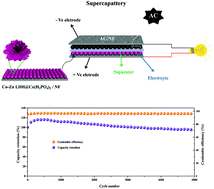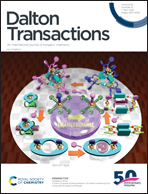Rational design of flower-like Co–Zn LDH@Co(H2PO4)2 heterojunctions as advanced electrode materials for supercapacitors†
Abstract
Layered double hydroxides (LDHs) with high theoretical specific capacity have been considered as one of the most promising candidates for high-performance supercapacitors. However, the low electronic conductivity and insufficient active sites hinder the further large-scale application of bulk LDHs. Here, we successfully synthesized heterostructured Co–Zn LDH@Co(H2PO4)2 nanoflowers by a simple hydrothermal method. As the amount of Co(H2PO4)2 in the whole heterostructure increases, the nanosheets steadily evolve into nanoflowers with a high surface area, providing more electrochemically active sites. Moreover, the built-in electric field formed between Co–Zn LDH and Co(H2PO4)2 improves the conductivity of the composite electrode. As a result, the as-prepared Co–Zn LDH@Co(H2PO4)2 shows a high specific capacity of 919 C g−1 at a current density of 1 A g−1. A hybrid supercapacitor (HSC) with activated carbon (AC) as the negative electrode and Co–Zn LDH@Co(H2PO4)2 as the positive electrode delivers an energy density of 30.4 W h kg−1 at a power density of 400 W kg−1, and 95.3% of the initial capacity is retained after 5000 cycles. This study provides a novel synthesis strategy for constructing heterojunctions to enhance the energy storage properties of LDH-based materials.



 Please wait while we load your content...
Please wait while we load your content...